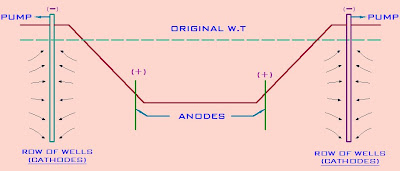Electrical stabilization of cohesive soil is performed using a process known as Electro-osmosis. A direct current (D.C) is supplied through clayey soil to migrate pore water to negative electrode (cathode). The strength of such soil is increased substantially as water is removed from it.
Electro-Osmosis
Electeo-osmosis is a method which drain water from cohesive soil with the help of direct current(D.C) . The cathode is a well point which collects the water, have to drained from the soil and discharges the water as in a conventional well-point system.

Mechanism of Electro-Osmosis
Cation (positive ions) are formed in pore water when the dissolved minerals go into solution. These cations move towards the negatively charged surface of clay minerals to satisfy the electrical charge. As the water molecules act as dipoles, the cations also attract the negative end of dipoles. When the cations move to the cathode, they take with them the attached water molecules.
Installation of System
Anodes are in the form of steel rods located near toe of the slope of the excavation. Cathodes are in the form of perforated pipes, resembling well points, installed in the soil mass about 4~5 m away from the slope of cut. The electrodes are so arranged that the natural direction of flow of water is reversed and is directed away from the excavation. This arrangement is required to prevent sloughing of the slopes.
System Requirements
The system requires about 20~30 amperes of electricity per well at a voltage of 40~180v. The consumption of energy is between .5 to 10 KWh/Cum. of soil drained.
Significance of Electro-Osmosis
As considerable amount of water is removed from the soil mass, the strength properties are increased. It is also found that a small reversing of the direction of flow helps in increasing the stability of the slope even if there is no significant decrease in the water content of soil. So this process also increase the slope stability substantially.
Limitation of Electro-Osmosis
This process requires specialized and sophisticated equipment as well as electrical consumption of high amount is associated with this process. Thus it is a highly expensive drainage process compared with other method.
Suitability
This method should be used only in exception cases when other method can not be used. It is normally used to drain water in a cohesive soil of low permeability of
K=1 x 10-5 to 1 x 10-8 m/sec
Fantastic Post! I am loving it!! Will be back later to study some much more.
ReplyDeleteDirect Supply of Concrete
wow nice 10q
ReplyDeleteThnx bro
ReplyDeleteGood one
ReplyDeleteWe are electric drill suppliers in singapore - manual and electric and other orthopaedic implants and instruments. VIEW MORE - Electric drill
ReplyDelete